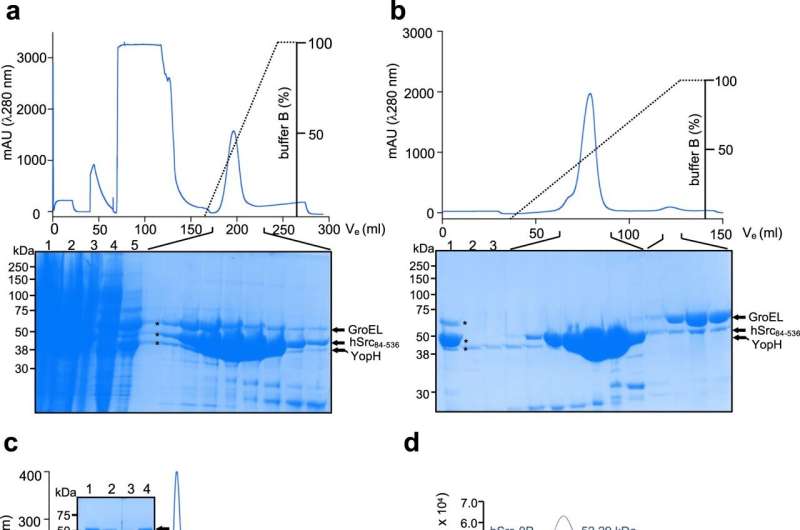This article has been reviewed according to Science X's editorial process and policies. Editors have highlighted the following attributes while ensuring the content's credibility:
fact-checked
peer-reviewed publication
trusted source
proofread
The first oncogene was found more than 40 years ago: Research discovers it has a previously unknown mechanism of action

In the late 1970s, the relationship between the c-Src gene and cancer was discovered. The first oncogene was identified. Since then, c-Src has been found to be overactivated in half of colon, liver, lung, breast, prostate and pancreatic tumors, but its function is not yet fully understood.
CNIO researchers have now discovered that this oncogene is capable of "self-activation," by means of a previously undescribed molecular mechanism. This finding has implications for the development of new drugs.
In recent decades, targeted therapy has been developed with the first drugs that act specifically against molecular targets (causes) of cancer, thus increasing their efficacy and reducing side effects. Many of these drugs inhibit the action of a type of enzymes called tyrosine kinases and have allowed a significant advance in the targeted treatment of several types of cancer.
Hence the relevance of the discovery made by researcher Iván Plaza-Menacho's group, at the Spanish National Cancer Research Center (CNIO): a new activation mechanism for the first known tyrosine kinase, which is also the first oncogene.
"We have found a new paradigm in the mechanism of action of the first identified oncogene, c-Src, with important implications for the discovery of next-generation drugs," explains Plaza-Menacho, head of the CNIO's Kinases, Protein Phosphorylation and Cancer Group.
The study is published in Nature Communications.
An oncogene overactivated in the most prevalent tumors
Kinases chemically modify other proteins by adding the chemical phosphate group to them, and this modification (phosphorylation) acts as a chemical signal that activates cell proliferation. When kinases malfunction, cells constantly receive the order to proliferate, leading to tumor formation.
This relationship between cancer and c-Src was molecularly discovered in the late 1970s, but it is not yet fully understood, despite the long time passed, and it is still under research.
The c-Src oncogene appears overactivated in approximately 50% of colon, liver, lung, breast, prostate and pancreas tumors. What the new work reveals is a new, unexpected mechanism by which c-Src can autonomously activate itself through autophosphorylation (the process by which a protein phosphorylates itself) and cause cancer.
An autophosphorylating oncoprotein
To date, it was known that the function and activity of the c-Src oncogene are controlled by another protein kinase, CSK, which phosphorylates a key tyrosine in c-Src to inhibit its activity.
But CNIO researchers now show that c-Src, in addition, "has the ability to autonomously regulate the phosphorylation of this key tyrosine by phosphorylating itself," says Plaza-Menacho.
The authors have managed to dissect at high resolution both the autophosphorylation sequence and the assembly process of the active molecule, which acts as a kinase, with the molecule that is phosphorylated, which acts as a substrate.
A therapeutic target in different types of cancer
There are inhibitors directed against c-Src activity with therapeutic applications. For example, dasatinib has been approved for the treatment of patients with multiple myeloid leukemia and acute lymphocytic leukemia. Clinical trials are currently ongoing in patients with metastatic breast cancer, colon cancer and prostate cancer with inhibitors targeting c-Src activity with other kinases, e.g. bosutinib, bafetinib or saracatinib.
The new results obtained by the CNIO group "have important implications in the design of and search for new generation drugs that block the allosteric and non-catalytic function of c-Src as a substrate in a more specific way," says Plaza-Menacho.
"In the future we want to determine the three-dimensional structure of c-Src in its complete format, and to know how it is assembled and with which molecules it is capable of interacting and regulating at the cellular level when it is hyperphosphorylated in cancer."
More information: Hipólito Nicolás Cuesta-Hernández et al, An allosteric switch between the activation loop and a c-terminal palindromic phospho-motif controls c-Src function, Nature Communications (2023). DOI: 10.1038/s41467-023-41890-7


















